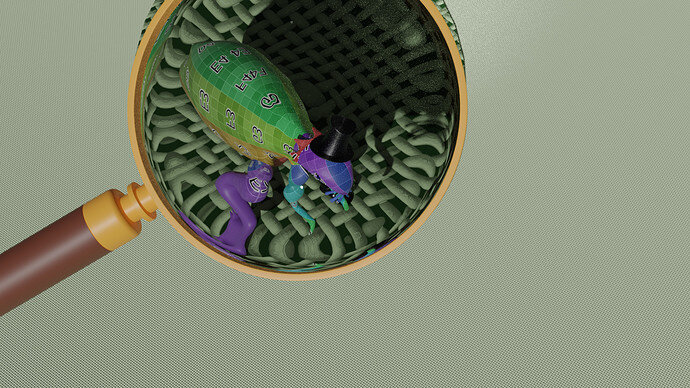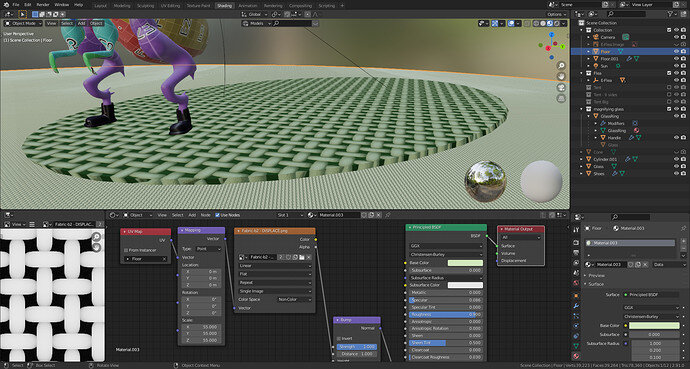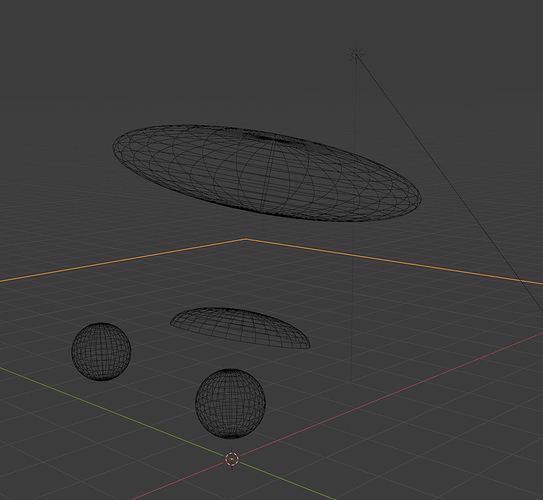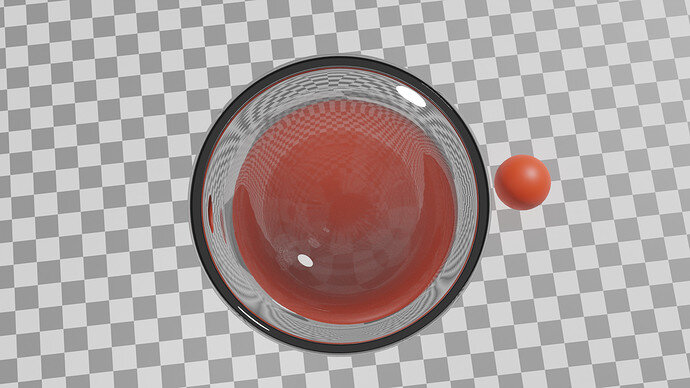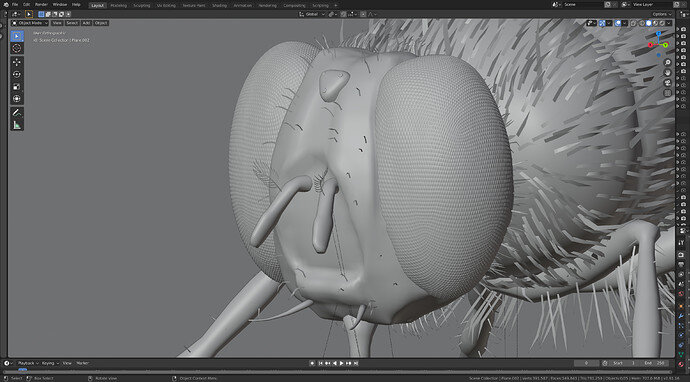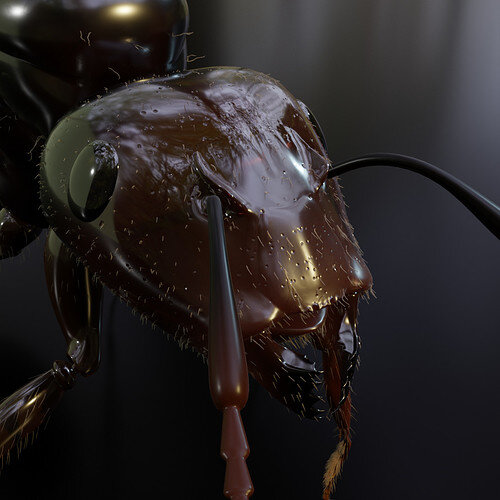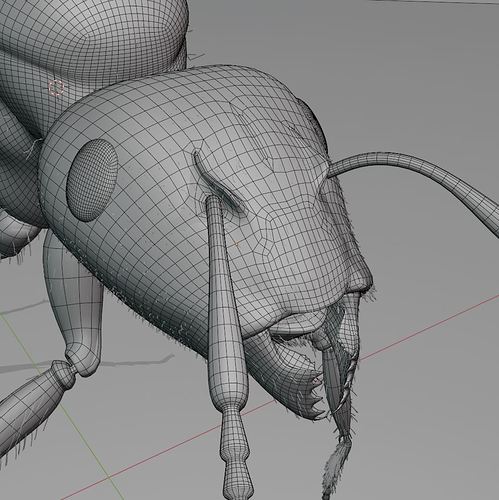I think the pattern is too heavy.
And the lens distortion is also a bit too strong at the borders.
I wouldn’t bother with working glass. Since you’re using trickery and magic just use slightly distorted glass instead. You have magnifying effect already. Very difficult and intriguing subject. I’m looking forward to see end result.
Sorry to keep snooping around your idea @FedPete but this spy glass has intrigued me. Here is combination I’ve came up with that has some kind of magnification.
Small half has focus set on whole perimeter of the ball and big one has small one in its full spectrum. Or something like that. It probably wont be any good for what you doing but I thought I’d share.
Great male winged ant!
How big have you made it while working on it?
Thanks!
Not sure how big it is. Since his torso begun as default cube it’ll be like 6m high in the end.
Face count? Several million. If I remember right it was about 15million tris in total with 6 x multi resolution divisions on head and torso. Crashed few times  Had to do one thing at the time in one moment… After baking it is 130k tris in total. That’s after subdivision x 2 for original mesh. It was ok after single subdivision but since its just a show piece I didn’t mind extra smoothness.
Had to do one thing at the time in one moment… After baking it is 130k tris in total. That’s after subdivision x 2 for original mesh. It was ok after single subdivision but since its just a show piece I didn’t mind extra smoothness.
Ah so you also end up making insects huge, I wondered if it was just me! I made mine, the wasp in last week’s collab much the same scale. Then when done scale it right down to life size. However you have put a much higher poly count into it, my intent was always to have an asset that could be used on anything so I knew the end use would be tiny and chose not to go to such fine detail as you have. Going from 2m long down to 23mm or some such I felt covered all end use detail useable. You ant is great and could be used much larger than life! Attack of the Godzilla of ants. 

I learned in my journey with Blender that metric scale means nothing. First thing that matters is your camera clipping. Second thing that matters is the poly count. Depending what you want to use it for. It is trough my ant has a high poly count, and surely if I look upon it in few months time I will go “phuh” that’s to much tris and its clumsy. But for now it’s a pinnacle of what I’m capable of. I’ve done character course and I’ve made giant orc who was complete 140K tris. And now I look at it and “oughh” Surely in our mind is bigger, those should have bigger count but devil is in details. As it is the tris count. I’ve payed attention to exoskeleton structures and all the details and crevices. surely not 100% correct. Proportions are wrong in many places. But this little animals sure have lots of details. They are marvels of nature. Truly. I mean, so many hairs on such a small body? C’mon. And when this grows to real thing. So does tris count 
I previously made a fly, after having domed every hexagonal eye part I accepted I needed to constrain my level of detail next time. lol. I suspect at use at life size there were ten or twenty pixels trying to draw hundreds of little domes.
You are right they are weird and interesting, the way they have really thin connections between relatively huge body parts is remarkable, they look like they should break if they ever move!
That’s the square-cube law. If object gets bigger in size its volume gets bigger faster than it’s surface area. Being, it would not be able to hold its own weight in multiplied size. Hence, no godzilla ants 
But. I’ve resigned so far from voronoi texture for eyes. Yours looks convincing.
I was hoping to find out about hexagonal design. I know this isn’t but. could you tell what was your approach?
All default options in Cycles and Eevee are based on this.
And yes it seems not of any influence but it is!
Eevee is more precise in this.
Like the sun lamp which generates a shadow’s softness, based on real earth sun parameters.
While working on a tiny creature, there is no need for millions of vertices.
You do it because you are zoomed in and because you can.
But unless you want to create a Godzilla-like scene.
A tiny creature is still tiny if you create a real-life scene.
A lot of students, performing the pyramid challenge, add a moon. But the moon is way too big. In real-life measurement, you can squeeze the moon between your fingers, to the size of a pea. 5mm.
It all depens on the way you are using the model.
It was a longish time ago, I think I used the tissue built in add on.
Sure metric matters if you do multiple things and they need to fit the scale. Or for lightning etc.
But it isnt changing details and the face count. Default cube 20m high and 2mm high will still have 6 faces. Thats what I mean.
Sure if I was doing a scene viewed from human perspective i could extrude three black blobs on the sticks and call it a day. Would have face count 50
But thats not the point of this exercise. I went in to the detail because thats how it looks up close. And thats how i will render it. Not swarm of milion.
My butterfly is block modeled. No need for many vertices
That’s cool, but you wasn’t going for lots of details as it’s covered in hair. My ant is block modelled to. But I needed high poly version for that perforation and all the cavities to bake on to normal map. And they wasn’t looking right at smaller subdivisions.
That is what it is right now.
What I do is using a grey scaled bitmap as a HEIGHT MAP input and paint the cavities.
Many ways to bake the bread.
More they are, steeper learning curve.

